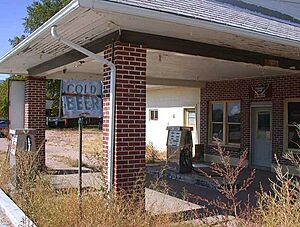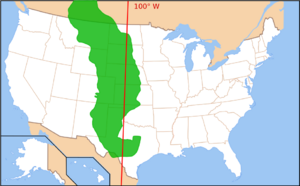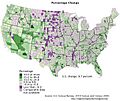Depopulation of the Great Plains facts for kids

The depopulation of the Great Plains is a big topic about many people moving away from the rural areas of the Great Plains in the United States. This happened mostly during the 20th century. People moved to bigger cities or to the east and west coasts. While people have moved from farms to cities all over the U.S., it was especially noticeable in the Great Plains. This includes states like Texas, Oklahoma, Kansas, Nebraska, South Dakota, North Dakota, Montana, Wyoming, Colorado, and New Mexico. In many parts of these states, more than 60 out of every 100 people left.
This movement started in the early 1900s. It sped up a lot during the Dust Bowl years in the 1930s. It has generally continued even up to the 2010 census. Many things caused this population drop. The main reasons include big changes in how farms operate, better ways to travel and connect cities, and fewer job opportunities in the countryside.
Contents
What are the Great Plains?
The Great Plains is a huge area in the middle of the United States. It covers parts of ten states: Colorado, Kansas, Montana, Nebraska, New Mexico, North Dakota, Oklahoma, South Dakota, Texas, and Wyoming. Imagine a map: the Great Plains stretch from about 97 degrees west longitude (a line on the map) all the way to the Rocky Mountains in the west. They go from the border with Canada in the north down to near Austin, Texas in the south. The U.S. Census Bureau says this area is about 533,100 square miles. That's about 18 percent of the entire United States!
The Great Plains are mostly flat. They used to be covered by huge grasslands. Today, the eastern part of the Great Plains is mostly used for farming. Wheat is a very important crop grown there. The western part is drier. It's mainly used for raising cattle and for farming that uses irrigation (bringing water to the crops).
Why Did People Leave?
People started settling in the Great Plains in large numbers after the American Civil War ended in 1865. By the late 1870s, the Plains Indians were mostly living on reservations. Many pioneer families moved to the region because of the free land offered by the Homestead Acts. By 1900, almost all the good farming land was owned by people or was part of Indian reservations.
However, the large number of farmers and ranchers who first moved to the Great Plains began to shrink. Several things caused this change. The most important reasons were economic. Over the 1900s, farming changed a lot. It went from small family farms that grew just enough for themselves to much larger farms that used more machines and needed fewer workers. Many small family farms just couldn't make enough money to survive.
Farmers also used methods that weren't good for the dry, windy weather and frequent droughts of the Great Plains. This became very clear during the Dust Bowl years of the 1930s. During this time, many people left the Great Plains even faster. Some areas had already started losing people as early as 1900.
Better roads and cars also played a role. Farmers could now live in bigger towns and cities instead of right on their farms. While cities in the Great Plains grew, thousands of small towns and communities disappeared. About two-thirds of the counties in the Great Plains lost some of their population between the early 1900s and the 2010 census. Many rural counties lost more than 60 percent of their people. Some counties even lost more than 80 percent! In some areas, there were fewer than two people living in a whole square mile.
Governments have tried different ways to stop people from leaving rural areas in the Great Plains. Some towns have even offered free land to new residents. However, these programs haven't been very successful. The main problem seems to be that there aren't many job opportunities in these small, faraway communities.
The population drop has led to some interesting ideas. One idea, called the Buffalo Commons proposal, suggests turning large parts of the drier Great Plains back into their natural state. This would mean the land would become pasture again for American bison (buffalo) and other animals that used to live there.
Counties with Big Population Drops
Many counties in the Great Plains have seen a huge drop in their population. For example, between 1900 and 2010, many counties lost more than 60% of their residents. Some lost over 80%. This shows how much the region has changed over the last century.
Sources: "County Population Census Counts, 1900-1990", accessed 29 April 2013; "USA counties", accessed 29 April 2013
Images for kids



